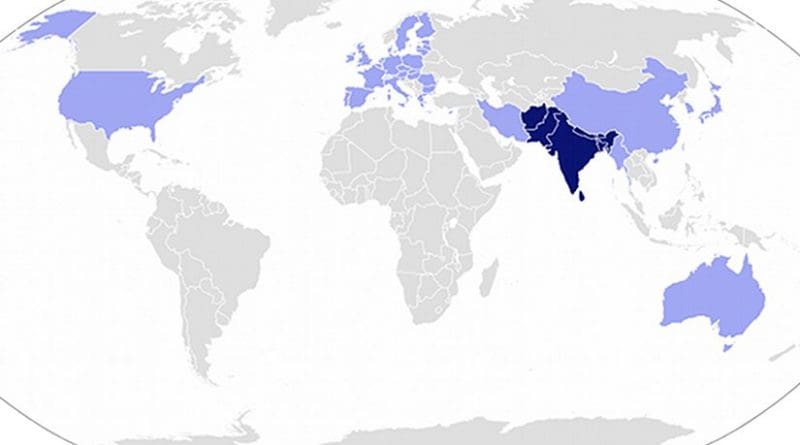The Saga Of SAARC And Realpolitik – OpEd
Asia is the most densely populated continent among all and within Asia—South Asia is done this credited to Asia by leaps and bounds. The total population of South Asia is about 1.6 billion which makes the 24% share of the world while stretched less than 4% of the earth surface. This bears the ability to be the hotspot for global market.
Along with this, the other side-wall of south Asia is the religion-very diversity. Each state has a dominant single religion. Hindu comprise 79.9% of Indian religion segment. And 81.3% population of Nepal. Similarly, Muslims are in majority in Afghanistan with ranges 99.7%, Bangladesh is also heavily Muslim populated with ratio of 96.28% and Pakistan is 89.1% while Maldives is 100% respectively. Buddhists are in majority with 72.1% and 73.2% in Sri Lanka and Bhutan. This give a blow to religious riots and hate against each other. This can be used and abused by states in the integration and disintegration of the region.
In the context of Joseph S Nye and Robert Cohen—the propagator of International Liberalism focused on the regional organizations. The theory of Complex Interdependence is the optimistic outlook of these organizations as a tool for the multipolarity and international peace and security. the same can be adopted to saarc—a regional organization is South Asia. But. Alas! The realpolitik of Thomas Hobbes and Niccolò Machiavelli superimposed over the liberals.
The South Asian Association for Regional Cooperation (SAARC) was established in December 8, 1985 after the signing of SAARC Charter in Dhaka, Bangladesh. The initiative was persuaded by the Bangladesh Zia Ur Rahman, the president, while later the vision was followed up by the president Hussain M Ershad. SAARC has its secretariat in Kathmandu, Nepal and established on 17 January 1987.
The main vision or objective of SAARC which are underlined in the Charter are:
The mission is to upgrade the life standard and welfare of the people of South Asia or the members of SAARC, to speed up the economic activities which is the gate way to economic growth in the region, blooms the rich cultural activities in order to bridge the people together and provide the chance to live in dignity with cultural relativism, to strengthen the collectiveness in the SAARC members; the way to mutual trust and to make the members states to understand the each other’s problems and brings a collective solution to problems.
But the reverse effect happened in the story of SAARC despite of bringing stability. One state is intentionally involved in the destabilization of the other. The cases are multiple; the issue of Sri Lanka. It badly hurt the core of Saarc when the Tamil, a separatist-terrorist group, with the support of a secular democratic state of India played a dirty politics in Sri Lanka. It killed and degraded every sphere of Sri Lankan society. The Indian Prime Minister Indira Ghandi urged the RAW and other intelligent institution to worked and provide weapons to Tamils.
This is not the only card India played in the regional hegemonic struggle. India has been involved in the Nepal domestic politics, the violation of Nepal’s right to sovereignty under the international law, since the independence of Nepal. India had been involved in the overthrowing the government, which is not pro-India, in Kathmandu in 1950s. later, the moist politics has been supported by India to undermine the state and to capture the Nepal foreign policy.
The other side: the Pak-Afghan bitterness can not be ignored in the region. Ahmed Rashid—one of the great expert on Afghanistan and Central Asia revealed in his book entitled Taliban: The Story of the Afghan Warlords—that Pakistan remained involved in the destabilization of Afghanistan in order to avoid the Afghan regimes attention from the Durand Line and paid 50 million dollar annually to the Taliban to pay the salaries to the government missionary. This thinking is bad for Saarc and the stability of South Asia.
The main and so-far basic hurdle in the route of Saarc is Indo-Pak realpolitik. Indo-Pak has been in a long history of enmity-enmity affairs. The major full scale wars, the Kashmir issues, recently the abrogation of the article 370 and 35-a of the Indian constitution undermine the status of Kashmir: it ablaze everything, the nuclear and conventional arms race. This is the way to stop SAARC to bring all under the thumb.
The way forward to make SAARC as like the EU of Asia then certain passion is needed to overcome. It can be; the solution of crucial and sensitive issues between members states as ASEAN did. The economic integration is followed by these geo-political settlement. The state have to certain that the lobbying to cancel or hijack the SAARC summits have to be stopped. Whatever the political environment is the summits have to take place. This is the only ray to bring all to a single table. Along with that the anxiety or security dilemma of small states have to be keep in because this is the pathway to make them more engaged in SAARC. The effectiveness of the SAARC is in the interest of all.
*Mujeeb Ullah holds a degree in International Politics based in Islamabad.

